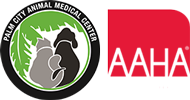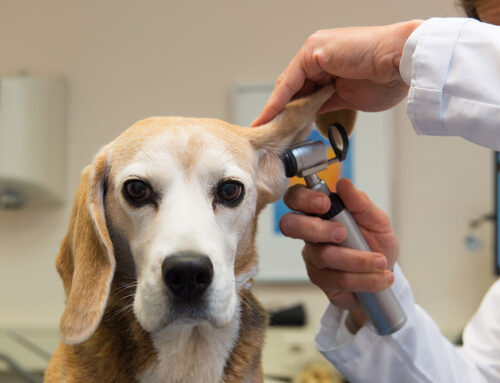Heatstroke occurs when an animal’s body overheats due to hot, humid weather conditions (environmental heatstroke) or due to strenuous physical activity (exertional heatstroke).
Florida’s high summer temperatures and high humidity are the biggest risk factors for heatstroke in our area, but certain activities such as exercising your pet when it is hot, leaving them in the car (even on cool days) or providing inadequate shade when outdoors can increase that risk further. Animals that are overweight and those with short noses (brachycephalic breeds such as the Pug, Shih Tzu, Bulldog, Pekingese, Lhasa Apso, Boston Terrier, etc.) are at particular risk for heatstroke because excess weight and brachycephalic conformation can make panting less effective which reduces an animal’s ability to cool themselves.

Heatstroke is a serious emergency that requires veterinary care. If you suspect your pet is experiencing heatstroke, bring them indoors or under shade quickly, apply cool, wet towels to their armpits and inner thighs then transport them to your vet.
The immediate signs of heatstroke include restlessness, panting, increased heart rate and drooling. As these signs progress, your pet may vomit or have diarrhea, the gums may become dark red or purple or your pet may become weak, stagger, have seizures or become unresponsive. Heatstroke can result in a very serious condition called systemic inflammatory response syndrome (SIRS) which can lead to multi-organ failure and even death. It is critical that animals with heatstroke be seen by a veterinarian as soon as signs are recognized so that aggressive treatment can be initiated.

The easiest way to avoid heatstroke is to keep your pet indoors when it is hot and to avoid over-exercising them, particularly during peak temperature times. If your pet does experience heatstroke, recognizing the signs, initiating cooling, then getting them to your vet quickly, will give them the best chance for survival and complete recovery.
A brief summary of the important points discussed in this article can be found below, or for more information about heatstroke or any other pet-related topic, contact Palm City Animal Medical Center at (772) 283-0920.
Recognizing Heatstroke
- Excessive panting and increased heart rate.
- Excessive drooling.
- Vomiting and diarrhea.
- Dark red, purple or blue gums.
- Weakness, staggering and/or seizures.
- Unresponsiveness or coma.
Preventing Heatstroke
- Keep your pet inside during peak temperature times.
- Exercise your pet when it is cool (early morning and late evening).
- Provide shade for your pet when outside, even if it doesn’t seem very hot.
- Bring fresh water with you if you take your pet to a park or to the beach.
- Do not leave your pet in the car at any time, even on cool days.
Treating Heatstroke
- Move them inside or under shade.
- Apply cool, wet towels to the armpits and inside thighs.
- Point a fan at them, if available.
- Seek veterinary care immediately. Heat stroke is a life-threatening emergency.
Established in 1981, Palm City Animal Medical Center is dedicated to providing the best possible care for your pets. With focuses on compassionate care in surgery, physical therapy and rehabilitation, preventative medicine, extensive diagnostics, and emergency service, Palm City Animal Medical Center combine exceptional medical care with a caring philosophy for pets and their owners. For more information, call 772-283-0920, visit www.palmcityanimalmedicalcenter.com or find us on Facebook at www.facebook.com/PalmCityAnimalClinic








Leave A Comment